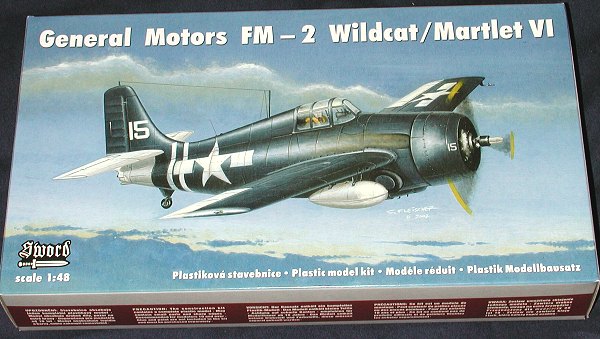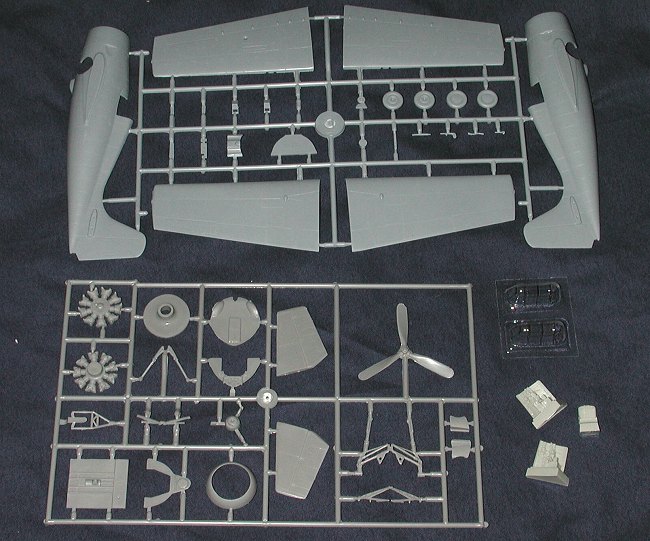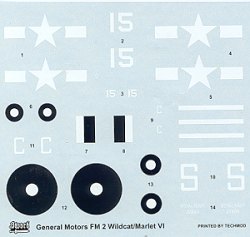
|
KIT: |
Sword 1/48 FM-2 Wildcat* |
|
KIT # |
48005 |
|
PRICE: |
$29.95 MSRP |
|
DECALS: |
Two Aircraft |
|
REVIEWER: |
|
|
NOTES: |
Short run with vac canopy and resin cockpit |

|
HISTORY |
As Tom Cleaver so eloquently put in his kitbash of the Tamiya kit, the FM-2 is indeed the Wildcat hot rod. The aircraft was initially designed by Grumman as the XF4F-8. The primary difference between this and earlier versions was the use of the Wright R-1820-56 series of nine cylinder radials in place of the Pratt & Whitney R-1830 two row 14 cylinder ones. The 1820s produced greater power and more torque than the P&W engines, necessitating the extension of the vertical tail surfaces to provide the needed stability.
Armament was reduced from six to four guns though each gun had more ammunition. The wing was strengthened to carry two 250 lb bombs, and later versions had zero-length rocket stubs for air to ground rockets. As Grumman did not have the production capacity to build the plane, General Motors was tasked with building the plane and used five of its east coast plants (hence the name Eastern Aircraft) to churn out over 4,700 of these planes. That made the FM-2 the most produced version of the Wildcat. The type also served with the Royal Navy as the Wildcat VI (though the decal sheet says Martlet VI, the Martlet name was dropped in 1944).
With these aircraft, the Navy had a potent fighter that was able to handle the smaller decks of escort carriers that were so important as use for convoy protection. Though quickly scrapped at the end of the war, a number of them have survived and are the most common Wildcat seen in museums or restored as warbirds.
|
THE KIT |

I think it is fair to say that this is probably the nicest Sword kit I have seen. There are two sprues of plastic, each a different shade of grey, on which the very nicely engraved parts are held. I was impressed at the high quality of the engraving and the lack of glitches that are so often seen on short run kits. No major problems with sink areas, though there are a few on some smaller parts, and the flash isn't a real problem, though again, you'll find some on the sprue with the prop. I saw no ejector pin marks and any stubs have already been cut away at the factory. The sprue gates are still fairly large so care is needed when removing smaller parts. One thing you will note is that there are not a lot of fiddly bits. This really helps to ease construction
Resin is confined to the cockpit with the seat (complete with belts) and
the side panels being in this material. The rest of the kit is in injected
plastic. You are given two vacuformed canopies and they are well done. This
allows you to cut them to have the interior displayed. The only omission I can
see is that there are no drop tanks. They are clearly shown on the box art, but
not included in the kit. You'll have to rob these from your
 Tamiya kit. The only area that I
can see that might cause concern is the installation of the wings. They are butt
joined, which in itself isn't a problem, but the wings are nearly solid plastic
so a bit heavier than normal. You may want to consider a spar of some sort.
Tamiya kit. The only area that I
can see that might cause concern is the installation of the wings. They are butt
joined, which in itself isn't a problem, but the wings are nearly solid plastic
so a bit heavier than normal. You may want to consider a spar of some sort.
The instruction sheet is very well done with the usual non-verbal construction sequence of drawings. Colors given are generic with no FS or ANA color callouts. The only thing I might question is the use of white for the wheel wells and cowling interior. Reference material such as the In Action series should be able to clear up this color quandary. The decals are by Techmod and appear to be superb. There are two versions given, one the box art plane from VC-99 aboard the USS Hoggatt Bay in mid 1945, the other a RN Wildcat VI from 882 Sq aboard the HMS Searcher, also in 1945. Both are overall dark sea blue. You'll have to paint the major white portions on the US plane and the bands on the RN version.
|
CONCLUSIONS |
I'm pretty psyched about this kit. Though not a huge Wildcat fan, I have
liked the FM-2 version and now we have one in 1/48 (the Airfix 1/72 Wildcat is
sort of an FM-2). I can tell you that I'm looking forward to building this one
and preliminary test fitting shows that it should be a winner.
|
REFERENCES |
Grumman Aircraft since 1929, R.J. Francillon, 1989
You can get this kit at Squadron Mail Order
If you would like your product reviewed fairly and quickly where it will be seen by well over 150,000 visitors a month, please contact me or see other details in the Note to Contributors.